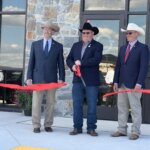
A Weekly Update from the Red River Farm Network
Monday, June 03, 2024
Off to a Good Start – In northeastern North Dakota, St. Thomas farmer Allen Tucker is pleased with his crops. “Our wheat looks just really great; I’m excited for our wheat crop and our barley crop,” Tucker told RRFN. “The sugarbeets are coming through well. They’re just tiny two–leaf beets, but there’s lots of them and they’re off to a great start.” Tucker’s early potato varieties are just beginning to emerge. The navies are planted and, as of Tuesday, the pinto beans weren’t in the ground yet.

A Completely Different Year – The spring has been a struggle In northwest Minnesota. “I think everybody assumed it was going to be a real early spring with the lack of snow and the mild winter and it’s a battle right to the end,” explained Shane Isane, who farms at Badger. “We’re in an area that was especially dry going into the fall and the drought map showed that we were in a definite drought area; it’s completely the opposite so far this spring.”
Saturated Soils – In the southern Red River Valley, GL Crop Consulting President Greg LaPlante fully expects to see some corn acres going to prevent plant. Unplanted fields are not the only issue for farmers. “The water table is full now so saturation is going to be an issue and we are going to have to determine the viability of the crop before we put much more money into it. We might have, for the first time in a long time, some failed acres.”

Prevent Plant Likely in Certain Areas – Farmers continue to struggle with wet conditions in northeastern South Dakota. Britton area farmer DuWayne Bosse says most of the corn was planted. For those remaining acres, Bosse isn’t sure if they will go prevent plant or switch to soybeans. “That might depend on the market,” said Bosse. “The bulk of it got in so I don’t want to make it sound like it’s a disaster here, but you get on the state line between us and Minnesota and, boy, there’s some wet areas there that are really struggling and are going to be more prevent plant than corn acres I’m afraid.”
Slow Planting in NE SD – For Peever, South Dakota farmer Bob Metz, planting has been very slow. “Probably the slowest that I have seen it, I would guess we are 25-to-30 percent planted,” said Metz. “We got started on the 24th of April and thought it was going to go great, but it has rained every three or four days since then.” Metz expects acres to shift from corn to soybeans. “We got as much corn in the ground as we can. People will probably switch to planting beans and there will be a lot of prevent plant on the corn acres.”

Weather Interruption – In the Jamestown area, farmers are struggling with soggy fields. Doug Reimers said the early start to the planting season helped, but progress has stalled by rain over the past few weeks. “We got a lot done right away and then the rain settled in. Lately, the rain has accumulated and really slowed down progress.” Reimers said replanting hasn’t been necessary, but that could change.
Fertility Challenges with Saturated Soils – NDSU Extension Soil Specialist Dave Franzen says the excessive rains over the past few weeks can possibly reduce sulfur and nitrogen in the soil. “On the sandier soils on either side of the (Red River) Valley, leaching is a problem; sulfur, nitrate, so that’s a possibility,” said Franzen. “The higher clay soils when you get closer to the river and have those really high, close to 50 percent clay soils, the movement of water through those is only maybe a third of an inch a day.” That means soils can remain saturated for an extended time.
Fertilizer Application Impacted by Wet Spring – According to Mosaic Senior Technical Sales Manager Sherry Koch, fertilizer demand has been steady to strong. “We had a good fall last year, which usually helps out in spring.” Some areas are seeing delays in planting due to saturation. “It’s one thing to have good conditions to plant into. It’s another thing when you’re trying to plant into mud.”

Pioneer Agronomy Update – The Pioneer Agronomy Update provides the latest cropping information for the region. In the latest edition, Pioneer Strategic Account Manager Cole Ehrlin says the majority of the soybeans in the region will likely be planted in June. “As a general rule, we recommend sticking with your original maturity plan on soybeans until roughly the middle of June, unless you’re already pushing the envelope for maturity in your area,” said Ehrlin. “If possible, seed to narrower rows; this will allow you help reach canopy closure quicker.” Listen to the update.
Early Season Weed Control – According to BASF Business Rep Nick Salentine, farmers are taking advantage of every opportunity to wrap up planting and handle weed control. “One common theme that I’ve heard across the countryside is the small grains are enjoying the cooler temperature, guys are starting to spray the wheat and we’ve got plenty of corn maps coming in with farmers getting ready to spray corn.” The on-again, off-again rains made it difficult to get a pre-emergent herbicide applied. “It seems like the guys that got the pre on had plenty of rain to get those pre’s activated, but unfortunately, there was also many fields that were geared up to get a pre that maybe didn’t they’ll have to rely on layering in residuals with an early post application.”
Disease Thrives on Moisture – The wet spring can lead to issues for emerging crops. BASF Technical Service Representative Dan Melaas advises farmers to look for any persistent wet spots in the field. “Really paying attention to moisture that lingers in the fields past 10 o’clock in the morning, that can lead to head scab,” said Melaas. “The more moisture we’ve got in the air and the crop canopy, the better chance we have of disease setting in.”
New Pest in Sugarbeets This Spring – According to University of Minnesota Extension Entomologist Ian MacRae, sugarbeet farmers have a new pest to consider this spring. “We’ve seen a lot of aster leafhoppers in the last week,” said MacRae. “It has six little dots on its face so it’s sometimes called a six-spotted leafhopper. We’ve seen them in small grains in the past, but this year we’re also seeing them in sugarbeets. A lot of those beets are quite young so we’re seeing some seeding damage.” Aster leafhoppers can spread disease through a variety of crops so early detection is important.
Scout Ditches for Hopper Nymphs – According to the NDSU Crop and Pest Report, grasshopper nymphs have started to emerge in ditches. The recent cool temperatures and rain delayed the hatch, potentially extending the season for hoppers into mid-July. Fields should be scouted each week. Broadleaf crops, like sugarbeets, sunflowers, canola, dry beans and soybeans, are more susceptible to than small grains.
Scout Early and Often for Alfalfa Weevil – Large populations of alfalfa weevils are being seen this year. CROPLAN Alfalfa and Forage Specialist Jeff Jackson credits the mild winter. “When it stays relatively nice we don’t have as many bugs die over the winter,” said Jackson. “That insect can hatch from fall and spring-laid eggs so you get two hatches of weevils.” Jackson recommends scouting early and often to stay ahead of this pest. “If you have a heavy infestation before you cut, they can eat those buds fast enough so you won’t see regrowth. My recommendation is be pre-scouting before you cut so you understand what is there so you can manage it when it comes off.”
What’s Hot, What’s Not in the Markets – In this week’s edition of What’s Hot, What’s Not in the Markets, Martinson Ag Risk Management President Randy Martinson says the wheat is seeing some support due to weather concerns. What’s not hot? “You’re going to have to go with most of the other markets,” replied Martinson. This past week, corn and soybeans put in a weekly key reversal. “This afternoon’s crop progress report will give us an idea about the corn conditions and planting progress.”
La Nina Transition Slower Than First Estimated – According to DTN Ag Meteorologist John Baranick, La Nina’s arrival looks to be delayed until July. Historical data shows the Northern Plains are likely to experience the most heat and dry weather once La Nina arrives, but Baranick says that it can be difficult to predict. For now, DTN models forecast dry, hot conditions for the Western Corn Belt. “From a historical perspective, especially for the upper Red River Valley, we typically see some hotter and drier conditions move in during the summer, especially during the second half of summer.”

Sugarbeet Report – In this week’s Sugarbeet Report, RRFN visits with American Crystal Sugar Company General Agronomist Joe Hastings about waterhemp and kochia control. Listen for the update.
Beet Crop in Great Condition – The sugarbeet crop in North Dakota and Minnesota has some of the highest USDA crop condition ratings ever. American Crystal Sugar Company General Agronomist Joe Hastings points to an early start and plentiful moisture. “I think we’ve had a lot of beets planted around April 27 so that starts it off good,” said Hastings. “With this moisture we’ve had made for some nice even emergence and decent stand counts.” There has some wind events, but the damage has been minimal. “It was mostly on cotyledon beets which can be pretty tough.”
PP Decision Tool Available From NDSU – North Dakota State University Extension has developed a spreadsheet to help farmers analyze and make prevented-plant decisions. This program compares the economics of prevented planting with late planting of that crop or a switch to another crop. The Excel spreadsheet tool is available on the NDSU website.
Farm Bill Isn’t on Senate Agenda Yet – With the House Agriculture Committee passage of the farm bill, attention shifts to the Senate. Iowa Senator Chuck Grassley said Senate Agriculture Committee Chair Debbie Stabenow is working across the aisle to find compromise. “I recently had a conversation with her, and she gave me a list of several things that I have an interest in that she hopes will bring me around.” However, Grassley doesn’t believe Majority Leader Chuck Schumer is ready to advance a farm bill. “He’s going to try to get things done that have support within the committees, but he doesn’t see a bipartisan agreement in agriculture and unless there’s a bipartisan agreement in ag there’s no point in putting it on the agenda.”

Fielding Questions – In this edition of Fielding Questions, AgCountry Farm Credit Services Senior Legislative and Public Affairs Officer Andy Barton discusses the next step in the farm bill process. The legislation has passed through the House Agriculture Committee and will reach the House floor in September. “It was a good first step,” reports Barton. The commodity and crop insurance titles in the House and Senate versions of the farm bill are similar. Barton said the biggest hurdle will be the funding for any new initiatives. The timing of the farm bill process is also discussed.

Working Out the Funding Gap – The House Agriculture Committee bill suspends Section 5 of the Commodity Credit Corporation Act, limiting the Agriculture Secretary’s authority to use CCC funds. Chairman Glenn ‘GT’ Thompson plans to use those savings to increase reference prices. The Congressional Budget Office has disagreed with the GOP staff about those budget savings. Minnesota Representative Michelle Fischbach is a member of the Budget Committee, working to ensure the CBO scores are accurate. “There are issues with some of the CBO scores because we need to make sure that we’re paying for everything great that we’ve done in the farm bill and so we’re working with CBO to make sure that they understand how things need to be scored so we can pay for that bill.”
Corn Matters – The House Agriculture Committee recently approved its farm bill proposal. Minnesota Corn Growers Association President Dana Allen-Tully offers her thoughts on the House language in this edition of Minnesota Corn Matters. Listen to the report.

The Bull Pen Report with Tommy Grisafi – This past month, new crop corn dropped off two-and-a-half cents. November soybeans rose 25 cents. September Minneapolis wheat is up 40 cents. August feeder cattle is up 90 cents and August hogs are down $6.90. As we move into a new month, Advance Trading Risk Management Advisor Tommy Grisafi highlights the market factors that should be monitored. “Do we get the last bit of the crop planted? Does inflation calm down or does it keep going? June will be the end of the second quarter and after that all eyes are on the election and weather, Mother Nature’s large in charge.” The full interview with Grisafi can be found on the Bull Pen Report on the Red River Farm Network YouTube Channel.
Another Dairy Farmworker Contracts H5N1 – H5N1 has been confirmed in a third farmworker. This is the second human case in Michigan and is part of the multistate outbreak in dairy cattle. This individual had minor respiratory issues and was treated with antiviral medication. The Centers for Disease Control and Prevention advises dairy farmworkers to use personal protective equipment as a biosecurity precaution. The virus has been identified in 66 dairy herds in nine states.
Testing Identifies H5N1 in One Meat Sample – USDA’s Food Safety and Inspection Service reports H5N1 has been confirmed in meat tissue from one dairy cow. Tests were conducted on 96 dairy cull cows and 95 cows tested negative. USDA emphasized none of the meat from any of these dairy cattle entered the food supply. Consumers are reminded to cook meat to the proper temperature.
USDA Launches Pilot Program to Protect Animal Ag Sector – Agriculture Secretary Tom Vilsack has approved an additional $824 million in emergency funding to respond to H5N1 in the U.S. dairy herd. The money will launch a new voluntary pilot program to give dairy farmers more options to monitor the health of their herds. The money will be used to support additional surveillance and testing. Farmers who enroll in this program and demonstrate their herd is free of the virus will be able to ship their cows without testing individual animals. USDA is now identifying states that will be part of this pilot program.
Stockpiling Vaccine – The United States is taking steps to acquire vaccines to protect at-risk poultry and dairy workers. Veterinarians and lab technicians could be eligible for H5N1 vaccines. The move is seen as a way to limit the threat of a pandemic. The Centers for Disease Control and Prevention said the decision to use vaccines will depend on reports of more cases or the severity or mutations of the virus. Other governments are also considering plans to stockpile vaccines.

A Milestone in NDSA History – More than 250 people turned out for the grand opening of the North Dakota Stockmen’s Association headquarters Thursday night. This dream began when NDSA delegates passed a directive in 2016 that launched this milestone. They directed the staff to start the search for a new headquarters. Land was purchased in 2021 and construction began last year. North Dakota Stockmen’s Foundation President Jeff Schafer said this was a historic milestone. “I can’t think of a greater compliment for an association or organization than to outgrow their building.” The NDSA moved into the new facility at the end of January and the first board meeting in the new building was held in March. “I had goosebumps the first time I walked in there; when I talk about life-changing moments, this will be one.”

A Landmark for the ND Cattle Industry – During the headquarters grand opening, North Dakota Stockmen’s Association President Jason Leiseth recognized three groups of people; the founders of the organization, the current membership and the next generation. “Our organization has a very strong track record of growth,” said Leiseth. “Who knows what the future holds for us, but at least building, we have a headquarters that we can continue to grow with and it will be a landmark for the cattle industry in North Dakota.” The ribbon cutting for the 10,000-square-foot facility was christened as the NDSA’s new home. Photos from the event can be found on RRFN’s Facebook page.
Built for the Next Generation – McVille rancher Dan Rovig chaired the North Dakota Stockmen’s Association and the North Dakota Stockmen’s Foundation Building Committee. Rorvig is proud of this new facility. “Our previous building served us well for 50 years, but we outgrew it as we added services, members and employees,” said Rorvig. “We hope this building will be serving our kids and grandkids 50 and 100 years from now.”
Celebrating 95 Years – The North Dakota Stockmen’s Association is enjoying record membership. NDSA Executive Director Julie Ellingson said new services have been added over the years. recognized the work that went into this moment. “Certainly, this new facility will help us serve that membership now and into the future.” On Thursday, the NDSA will recognize another important milestone. It’s been 95 years since the organization started in Watford City to address widespread cattle rustling in the region. “It’s hard to believe we are on the heels of 100 years and I can’t help but think about the vision these livestock producers had back in 1929. I hope as they look down on us, it makes them proud to see that vision came to life and expanded even beyond.”
Denver Ballot Issue Will Impact Sheep Producers Nationwide – The Colorado State University Regional Economic Development Institute has evaluated the economic consequences of a potential Denver meat processing ban. The ballot measure will be up for a vote in November. If passed, the Superior Farms lamb processing plant would be forced to close. This is the largest lamb processor in the country and would result in the loss of up to 20 percent of U.S. lamb harvest capacity.
Cow-Calf Producers Lose Price-Fixing Court Case – U.S. District Judge John Tunheim has ruled against a group of cow-calf producers from Kansas, Missouri, Nebraska and Tennessee. These farmers claimed Tyson Foods, JBS, Cargill and National Beef Packing conspired in 2015 to limit fed cattle trade and reduce cattle prices. Tunheim said the cow-calf producers do not have a standing in this case because they were not directly impacted by the downturn in fed cattle prices nearly ten years ago.
Ractopamine Found in Shipment to China – Traces of the feed additive ractopamine were found in a JBS beef shipment to China. The JBS plant in Greeley, Colorado is the one involved in this situation and shipments to China have been suspended. JBS is working with U.S. and Chinese authorities to resolve the issue.
MN Beef Update – Minnesota Beef Council Director of Industry Relations Jon Dilworth is featured in the latest episode of the Minnesota Beef Update. Dilworth highlights in the recent ‘best burger’ competition. The Minnesota Beef Checkoff is also participating in Grillfest. Listen to the update.
Happy Calves – According to NDSU Extension Livestock Economist Tim Petry, the muddy spring had little influence on calving this spring. “Calving has been going very well this year and it’s been a much improved calving season.”
A Garden of Eden – University of Minnesota Extension Beef Specialist Eric Mousel is impressed with current pasture conditions. “Pastures look fantastic compared to the last four years, like a Garden of Eden,” said Mousel. “The more open winter allowed all of the rain to soak in.” Pastures have plenty of moisture, but previous dry years still have an impact. “Even though pastures are greening up and growing right now, they are a little bit thin. It’s going to take a little bit of time for them to fill in and recover from the dry weather.”
Consider Your Fly Control Timing – According to NDSU Extension Veterinarian Gerald Stokka, it is important to pay attention to cattle to know when to utilize fly control. “Cattle suffer the most when they are bunched up under shade. You can do something to alleviate some of that fly population.” Fly control timing is vital to avoid resistance. The longer flies are exposed to a control product, the easier it is to create resistance. “Typically, flies become a problem in late June to July, certainly in August; If you can put off some of those strategies for actual application, those products have a greater chance of working better.”
MFU Minute – Minnesota Farmers Union Program Director of Climate and Working Lands Arial Kagan joins the MFU Minute to discuss the recipients for the second round of grant funding for the Cooperatives for Climates initiative. Listen to the report.
Carbon Offset Guidelines Issued – The Biden Administration has announced new guidelines for carbon credits or offsets. This guidance said credits should represent actual and additional reductions in carbon emissions. An accredited, independent third party should validate the carbon offsets. The carbon markets have faced problems, including double counting. This decision is designed to protect the integrity of the system.
Farming for the Future – The Minnesota Department of Agriculture is partnering with the Red River Farm Network and the Linder Farm Network to provide information on soil health events and topics. This week, Glenn Hjelle, who is a water quality-certified producer in Grant County. talks about the conservation work he does on his farm. Listen to Farming for the Future.
OPEC+ Extends Voluntary Production Cuts – After a weekend meeting, the OPEC+ nations have agreed to extend its oil production cuts into 2025. The voluntary cuts are in response to high interest rates and increased U.S. oil production. The next meeting for the OPEC+ nations will be in December.
U.S. Barley Growers and Mexican Brewers Discuss ’24 Crop – The U.S. Grains Council hosted a virtual meeting between Mexican brewers and barley farmers from North Dakota, Montana, Idaho and Washington. The farmers highlighted crop conditions and the outlook for the season. Barley demand in Mexico has increased significantly in recent years.
Canadian Border Agents May Strike – Canadian border agents have voted to strike in a dispute over wages, retirement benefits and workplace rules. The Canadian government said it is fully committed to reaching a fair deal with the border service employees. Mediation is scheduled to begin on June 3. Canada is a leading export market for U.S. farm products and that trade is at risk if the strike moves forward.
Canola Minute – The latest NDSU Crop and Pest Report includes an update on flea beetle concerns in canola. In this week’s Canola Minute, Northern Canola Growers Association Executive Director Barry Coleman highlights the importance of scouting and treatment. Here’s the report.

FFA Members in Fargo This Week – The North Dakota FFA State Convention is underway this week. State FFA Advisor Nikki Fideldy-Doll is excited to have members from across the state together for the convention. “This is our 95th North Dakota FFA State Convention held at NDSU and each year it brings some exciting opportunities for over 1,400 individuals in attendance.” Fideldy-Doll is especially excited to see the growth of the state officer team and the installation of the new officers. “This is the last item for our state officer team and near the end of the week we will elect the new state officer team. That is always a highlight.”

ND Poll Offers Insight into GOP Governor, House Races – According to a poll conducted by WPA Intelligence for the North Dakota News Cooperative, Congressman Kelly Armstrong is the leading Republican in the gubernatorial race. Out of 500 people polled, Armstrong has the support of 57 percent. That compares to 19 percent for Lt. Governor Tammy Miller. The results are closer for North Dakota’s House race. Public Service Commissioner Julie Fedorchak received 32 percent support. Former State Representative Rick Becker has 25 percent and Bismarck attorney and former Miss America Cara Mund has ten percent. Twenty-eight percent of those polled said they were undecided. North Dakota’s primary election is June 11.
ND Supreme Court Rules in Favor of Summit Carbon Solutions – Summit Carbon Solutions won a victory in the North Dakota Supreme Court. A lower court ruling was allowed to stand, giving Summit Solutions the right to survey property without the landowners’ permission. This pipeline project would connect 57 ethanol plants to carbon storage northwest of Bismarck.

Advocating for Minnesota Soybean Farmers – Minnesota Soybean Growers Association President Bob Worth was content with the state legislative session. “We stopped a lot of things that were going to really hurt.” Worth was impressed with the cooperation seen by Minnesota farm groups during the session. “This is the year that we all worked together at the Capitol and that’s really exciting because it hasn’t been that way for a while.” Worth is the first MSGA president to serve multiple two-year terms. The Lake Benton farmer’s first time in MSGA leadership was from 2005-to-2007. Worth returned to the presidency in 2022 and will wrap up his term at the end of the month.
Increased Profitability for Water Quality-Certified Farms – Farmers in the Minnesota Agricultural Water Quality Certification Program have higher profits than non-certified farms. AgCentric Executive Director Keith Olander attributes the profitability to their management characteristics. “We have over 100 producers that are agricultural water quality-certified that span the state of Minnesota and they are also part of farm business development. We have developed a five-year run of the economics of those producers. They are outperforming their peers on a regular basis.” Certified farms had an average net cash income of nearly $214,000 compared to $163,000 for non-certified farms. Certified farms also had better debt-to-asset and operating expense ratios.
AFREC Soil Fertility Minute – Northwest Research and Outreach Center Nutrient and Water Management Specialist Dr. Lindsay Pease joins this week’s Soil Fertility Minute to discuss fertility management practices and how they need to change when adding cover crops. This report is sponsored by the Agricultural Fertilizer Research and Education Council and can be heard online.
BWSR Grant Funds Available – The Minnesota Board of Water and Soil Resources is providing $6.4 million to soil and water conservation districts to support soil health projects. The SWCDs can request funding through July 2. The money can be used to help landowners implement conservation practices or for outreach and education projects.

Dry Bean Scene – In this week’s Dry Bean Scene, Johnstown Bean Company General Manager Dylan Karley discusses planting process and how the wet weather has affected the crop. Listen to the report.
New Wheat Herbicide Available Now – The Environmental Protection Agency has approved the registration of a new wheat herbicide from UPL. Technical Service Manager Nathan Popiel says IronGate delivers control of a wide spectrum of grasses and broadleaf weeds. The use rate is 1.75 fluid ounces per acre,” said Popiel. “This nice low-use rate product will be available to growers in 80-acre jugs so it is handy for them that way. With that formulation, they’re not adding a lot to the tank, not taking up a lot of space on the shelves or on the spray truck.” IronGate has a wide application window with excellent tank-mix flexibility.
Protecting the Crop From CRW Damage – GUARD X is the first-ever EPA-approved corn rootworm biological to be delivered to the furrow through the patented BIO-CAPSULE Technology fluency system. Meristem Crop Performance says the new tool provides a new mode of action to protect the crop from corn rootworm damage.
First-in-Class Methane Reducing Feed Ingredient Gets FDA Approval – For the first time, the Food and Drug Administration has approved a feed ingredient for dairy cattle that will reduce methane emissions. Elanco Animal Health already has approval for Bovaer in Canada and Mexico. This product suppresses the enzyme in the cow’s rumen that forms methane. One tablespoon of Bovaer per lactating dairy cow can reduce methane emissions by 30 percent per year.
Another Miilestone for Epitome Energy Project – The North Dakota Department of Environmental Quality has approved Epitome Energy’s air permit for its proposed soybean processing plant in Grand Forks. Construction is scheduled to begin later this year with production beginning in 2026. The Epitome Energy plant will process up to 42 million bushels of soybeans per year.
Record Year for State-Owned Bank – The state-owned Bank of North Dakota is reporting record profits of $192.7 million for 2023, up $1.5 million from the previous year. The Bank also had a return on investment of more than 18 percent. The total lending portfolio was a record $5.8 billion, an increase of $394 million from 2022. One of the programs cited was the Livestock Rebuilders Loan which helped ranchers replenish 16,000 head of cattle lost in the state due to the 2021 drought.
Runnings to Purchase Home of Economy Stores – North Dakota’s Home of Economy stores are being acquired by Marshall, Minnesota-based Runnings. The Home of Economy franchise is based in Grand Forks and has locations in Grafton, Devils Lake, Rugby, Minot, Williston, Jamestown and Watford City. This deal is expected to be finalized in September.
Free Concert Returns to Big Iron – Big Iron Farm Show management has announced Lee Greenwood will deliver a free concert on Wednesday, September 11. The concert will be at the grandstand that evening. Greenwood is known for the classic ‘God Bless the USA.’ Country singer Rodney Atkins hosted a similar concert last year.
SD Corn Comments – In the South Dakota Corn Comments, Air Force Lt. Col. Aaron Drenth offers a Memorial Day message. Drenth is from Bryant, South Dakota.
Central Livestock Adds to the Team for Canadian Expansion – Central Stockyards, which hosts the weekly online Fed Cattle Exchange, has hired Brent Difley and Cassidee Rogers. Difley is the new business development manager for Canada and spent his career in the animal health business. Rogers is the business operations coordinator and has broad experience in the cattle feeding industry. The additions to the team were made to prepare for the addition of Canadian feedyard and packer participation in its weekly sales.

New Executive Director on the Job for ND FFA Foundation – The North Dakota FFA Foundation has a new executive director. For the past six years, Laiken DeMorrett was the advocacy director for the North Dakota Women’s Business Center. DeMorrett was an FFA member in high school where she earned her American FFA Degree. “FFA has played a significant role in shaping my life and I am excited to give back to an organization that has given me so much,” said DeMorrett. “I look forward to working with the team to support and inspire the next generation of agricultural leaders.”
Holt Moves to NDFB – NDFB has hired Molly Holt as its southwest field representative and advisor to the Dickinson State Collegiate Farm Bureau. Previously, Holt was a Purina livestock production specialist for Craven Feeds. Holt is a graduate of North Dakota State University and grew up on a ranch at Stanley, South Dakota.
Last Week’s Trivia- Chris Finch, Bill Musselman, Sidney Lowe, Randy Wittman and Flip Saunders are all former head coaches of the Minnesota Timberwolves. Rolla, North Dakota farmer Doyle Lentz wins our weekly trivia challenge. Runner-up honors belong to Todd Good of AgCountry Farm Credit Services, retired controller Evonne Wold, Mackenzie Derry of CHS Ag Services and Dan Durheim of Nationwide. The ‘first 20’ rounds out with Kevin Schulz of The Farmer, retired NDSU Extension dairy specialist J.W. Schroeder, Keith Bjorneby of Lone Wolf Farms, Karlstad farmer Kurt Aakre, Pisek farmer Ernie Barta, Harvey farmer Bill Ongstad, retired UM Extension Educator Russ Severson, Kennedy farmer Jeff Mortenson, Brian Sieben of Hefty Seed, Erin Nash of National Association of Farm Broadcasting, Renville County farmer Micky Peterson, Thomas Ternes of Capitol Credit Union, R & J Broadcasting President/owner Jim Birkemeyer, Bob Lebacken of RML Trading and Ramsey County farmer Paul Becker.
This Week’s Trivia-What gemstone is created inside of an oyster? Send your answer to don@rrfn.com. We’ll recognize the top responses in next week’s newsletter. Be sure to include your job title or hometown when you provide your trivia answer.
| Contact RRFN | Don Wick (701) 795-1315 |
Randy Koenen (701) 795-1315 |
Tyler Donaldson (701)-795-1315 |
Jamie Dickerman (701)-795-1315 |
| RRFN Affiliate Stations | |||
| Aberdeen, SD – 105.5 FM | Ada, MN – 106.5 FM | Bagley, MN – 96.7 FM | Bemidji, MN – 1300 AM |
| Benson, MN – 1290 AM | Bismarck, ND – 1270 AM | Bismarck, ND – 1270 AM | Casselton, ND – 103.9 FM |
| Crookston, MN – 1260 AM | Devils Lake, ND – 103.5 FM | Fergus Falls, MN – 1250 AM | Fosston, MN – 1480 AM |
| Glenwood, MN – 107.1 FM | Grafton, ND – 1340 AM | Jamestown, ND – 600 AM | Langdon, ND – 1080 AM |
| Mahnomen, MN – 101.5 FM | Mayville, ND – 105.5 FM | Roseau, MN – 102.1 FM | Rugby, ND – 1450 AM |
| Thief River Falls, MN – 1460 AM | Wadena, MN – 920 AM | Warroad, MN – 92.5 FM | Worthington, MN – 730 AM |
FarmNetNews is a production of the Red River Farm Network. RRFN is based in Grand Forks, North Dakota and provides news to farmers and ranchers across Minnesota, North Dakota and South Dakota.

- Follow RRFN on

